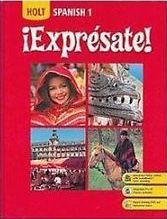
Expresate!: Spanish 1
1st Edition
ISBN: 9780030452048
Textbook solutions
All Solutions
Page 20: 26
Exercise 1
Step 1
1 of 3
In this question, you’re asked to write and say out loud the time that you’re given by the digital clocks. The first question gives you “4:00 PM”.
Step 2
2 of 3
There are three important parts to reading time: The hour, the minutes, the “AM” vs “PM”. Obviously, the hour in this one will be *cuatro*. As for the minutes, recall that when the time lands squarely on an hour mark, we use the phrase *en punto* to say “on the dot”.
Finally, your vocab on page 20 tells how to indicate “in the morning”, “in the evening” and “in the night”. It is partially up to your discretion when to draw the line between evening and night, but in this case I would use the phrase *de la tarde* since 4 PM is still the afternoon.
Result
3 of 3
Son las cuatro en punto de la tarde.
Exercise 2
Step 1
1 of 3
In this question, you’re asked to write and say out loud the time that you’re given by the digital clocks. The second question gives you “6:10 AM”.
Step 2
2 of 3
Again, the three important parts are the hour (6), the minutes (:10) and the “AM/PM” differentiation. Since our time falls under the half hour mark (6:30 being the half hour mark), we will be adding the minute to the hour as opposed to subtracting the minutes from the following hour. Finally, our vocabulary tells us that “de la mañana” means “in the morning”.
Result
3 of 3
Son las seis y diez de la mañana.
Exercise 3
Step 1
1 of 3
In this question, you’re asked to write and say out loud the time that you’re given by the digital clocks. The third question gives you “12:00 PM” a.k.a noon.
Step 2
2 of 3
While you could approach this question the same as the previous ones “hour, minutes and AM/PM”, if you look at the vocabulary on page 20, you’ll see that there is a specific phrase for noon and midnight.
Result
3 of 3
Es mediodía.
Exercise 4
Step 1
1 of 3
In this question, you’re asked to write and say out loud the time that you’re given by the digital clocks. The first question gives you “9:05 AM”.
Step 2
2 of 3
*Nueve* will be the word to use for hours (9), and since the minutes are under the half hour mark, we will be adding them instead of subtracting them from the following hour. Finally, AM implies we will be using *de la mañana* instead of *de la tarde* or *de la noche*.
Result
3 of 3
Son las nueve y cinco de la mañana
Exercise 5
Step 1
1 of 3
In this question, you’re asked to write and say out loud the time that you’re given by the digital clocks. The fifth question gives you “4:45 AM”.
Step 2
2 of 3
Here we have a time given that is between the half hour mark and the next hour (4:30-5). This means the Spanish translation will involve subtracting minutes from 5 o’clock to arrive at 4:45. Since 4:45 is 15 minutes (one-quarter of an hour) before 5, we would say “it is 5 minus a quarter”.
We also know thanks to our vocab that *de la mañana* means “in the morning” which would signify “AM”.
We also know thanks to our vocab that *de la mañana* means “in the morning” which would signify “AM”.
Result
3 of 3
Son las cinco menos cuarto de la mañana.
Exercise 6
Step 1
1 of 3
In this question, you’re asked to write and say out loud the time that you’re given by the digital clocks. This final question gives you “1:15 PM”.
Step 2
2 of 3
Any time beginning with 1:00 is unique in Spanish, because since we’re talking about one as a singular concept, we use *es la una* instead of using *son* like we do with every other time (like *son las tres y cuarto*).
Finally, since 1:15 PM is definitively an “afternoon” time, we would end our sentence with *de la tarde* (in the afternoon).
Result
3 of 3
Es la una y cuarto de la tarde.
unlock

